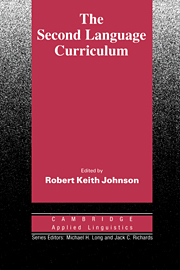Book contents
- Frontmatter
- Contents
- Contributors
- Series editors' preface
- Acknowledgements
- Overview
- I 1 CURRICULUM OVERVIEW
- I 2 CURRICULUM PLANNING
- II ENDS/MEANS SPECIFICATION
- III PROGRAMME IMPLEMENTATION
- IV CLASSROOM IMPLEMENTATION
- Chapter 11 Hidden agendas: the role of the learner in programme implementation
- Chapter 12 The evaluation cycle for language learning tasks
- Chapter 13 Seeing the wood AND the trees: some thoughts on language teaching analysis
- V EVALUATION
- Bibliography
- Index
Chapter 11 - Hidden agendas: the role of the learner in programme implementation
Published online by Cambridge University Press: 05 October 2012
- Frontmatter
- Contents
- Contributors
- Series editors' preface
- Acknowledgements
- Overview
- I 1 CURRICULUM OVERVIEW
- I 2 CURRICULUM PLANNING
- II ENDS/MEANS SPECIFICATION
- III PROGRAMME IMPLEMENTATION
- IV CLASSROOM IMPLEMENTATION
- Chapter 11 Hidden agendas: the role of the learner in programme implementation
- Chapter 12 The evaluation cycle for language learning tasks
- Chapter 13 Seeing the wood AND the trees: some thoughts on language teaching analysis
- V EVALUATION
- Bibliography
- Index
Summary
Introduction
In this paper, it is suggested that the effectiveness of any language programme will be dictated as much by the attitudes and expectations of the learners as by the specifications of the official curriculum. The assumption that there is a one-to-one relationship between teaching and learning is questioned, and it is hypothesised that learners have their own agendas in the language lessons they attend. These agendas, as much as the teacher's objectives, determine what learners take from any given lesson or teaching/learning encounter.
In order to explore the ‘hidden agenda’ hypothesis, studies into learner perceptions of learning processes are reviewed and compared with teacher perceptions. These studies provide a basis for the interpretation of classroom interactions which reveal the ‘hidden agendas’ of the learners in action.
The final section of the paper discusses some of the practical implications of the hidden agenda hypothesis, and suggests some practical techniques for achieving a synthesis between the official and the hidden curriculum.
The scope of the language curriculum
Recently there has been a call for a more systematic approach to language curriculum development. Thus, Richards (1984b) suggests that, in contrast with general educational practice where curriculum development is a ‘major educational industry’:
what is understood by curriculum development in language teaching has often been rather narrowly conceived. The focus has been primarily on language syllabuses rather than on the broader processes of curriculum development.
(Richards, 1984b: 1)- Type
- Chapter
- Information
- The Second Language Curriculum , pp. 176 - 186Publisher: Cambridge University PressPrint publication year: 1989
Accessibility information
- 21
- Cited by

